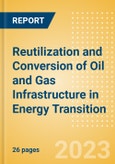In an environment of an accelerated energy transition, it's important to evaluate the potential reuse of either abandoned or operating oil and gas infrastructure, which can ultimately help to achieve huge savings on the CCS chain, hydrogen cost, and renewable fuels.
Retrofitting oil and gas infrastructure has the potential to save millions of dollars and accelerate the transition to clean energy. Depleted oil fields can be repurposed for long-term CO2 storage by adapting them to the production well allocation, similar to Enhanced Oil Recovery (EOR) projects. The number of Carbon Capture and Storage (CCS) projects worldwide, particularly in the United States, for permanent CO2 geological storage and EOR projects, is expected to rise significantly by 2030. The feasibility of repurposing oil and gas pipelines for hydrogen transport depends on the method of hydrogen production. Conversely, pipelines can be more easily adapted for CO2 transport if they are offshore, where they have better mechanical properties, making them more resistant to dense-phase CO2 transport. Retrofitting refineries to produce renewable fuels and biofuels can improve their economic performance by reducing their exposure to economic shocks such as rising oil prices. However, due to the technical challenges involved in repurposing, there will likely be more standalone renewable refineries in the future than converted crude refineries.
Retrofitting oil and gas infrastructure has the potential to save millions of dollars and accelerate the transition to clean energy. Depleted oil fields can be repurposed for long-term CO2 storage by adapting them to the production well allocation, similar to Enhanced Oil Recovery (EOR) projects. The number of Carbon Capture and Storage (CCS) projects worldwide, particularly in the United States, for permanent CO2 geological storage and EOR projects, is expected to rise significantly by 2030. The feasibility of repurposing oil and gas pipelines for hydrogen transport depends on the method of hydrogen production. Conversely, pipelines can be more easily adapted for CO2 transport if they are offshore, where they have better mechanical properties, making them more resistant to dense-phase CO2 transport. Retrofitting refineries to produce renewable fuels and biofuels can improve their economic performance by reducing their exposure to economic shocks such as rising oil prices. However, due to the technical challenges involved in repurposing, there will likely be more standalone renewable refineries in the future than converted crude refineries.
Key Highlights
- Advantages and Disadvantages of upstream, midstream and downstream infrastructure retrofitting of each energy transition technology
- Outlook of CCS projects, Europe's pipeline length distribution, upcoming crude converted/co-processing refineries
- Case studies of pipeline retrofitting for CO2 and Hydrogen transport
Scope
- Brief about the reasons to retrofit existing oil and gas infrastructure
- Description of the typical cycle of CCS for CO2 geological storage
- What to consider when retrofitting wells, fields, pipeline and equipment for CO2 geological storage/enhanced oil recovery
- List of advantages and disadvantages, from an environmental and social/economic point of view, of upstream infrastructure retrofitting for CCS
- Description of the requirements for pipeline retrofitting for CO2 and hydrogen transport
- Descriptions of the technical aspects and requirements of transporting CO2 and Hydrogen in hydrocarbon pipelines
- Description of equipment adjustments and requirements to consider when retrofitting midstream infrastructure
- List of advantages and disadvantages, from an environmental and social/economic point of view, of pipeline retrofitting for CO2 and hydrogen transport
- Renewable fuels and biofuels production cycle
- Companies involved in converting their crude refineries to process/co-process renewable fuels and biofuels
- List of the most important upcoming crude conversion/co-processing projects
- Comparison between converted/co-processing refineries vs standalone renewable fuels refineries
- List of advantages and disadvantages, from an environmental and social/economic point of view, of downstream infrastructure retrofitting
Reasons to Buy
- Identify the main technical aspects involved in oil and gas infrastructure retrofitting for CCS, CO2 transport, hydrogen transport, and renewable fuels and biofuels production
- Identify the most important companies involved in upstream and downstream infrastructure retrofitting
- Demonstrate the savings that can be achieved by pipeline retrofitting for CO2 and hydrogen transport.
Table of Contents
- Introduction: why to reuse/convert O&G infrastructure
- Upstream Infrastructure: Carbon Capture and Storage
- Midstream Infrastructure: Pipeline reuse for CO2 and Hydrogen transport
- Downstream Infrastructure: Crude Refinery conversion/co-processing
- Contact the Publisher
Companies Mentioned (Partial List)
A selection of companies mentioned in this report includes, but is not limited to:
- Equinor ASA
- Exxon Mobil Corp
- Summit Carbon Solutions LLC
- Occidental Petroleum Corp
- Ineos AG
- Drax Group Plc
- Santos Ltd
- Prairie State Energy Campus LLC
- Enchant Energy Corp
- Calpine Corp
- Marathon Petroleum Corp
- Shell Plc
- HF Sinclair Corp
- PT Pertamina (Persero)
- Preem AB
- Eni SpA
- Imperial Oil Ltd
- PBF Energy Inc
- Phillips 66
- North Atlantic Refining Ltd
- and TotalEnergies SE.








